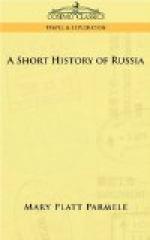All this was very splendid. But things were moving with the momentum gained by his father, Ivan the Great. It was Vasili’s inheritance, not his reign, that was great. That inheritance he had maintained and increased. He had humiliated the nobility, had developed the movements initiated by his greater father, and had also shown tastes magnificent enough for the heir of his imperial mother, Sophia Paleologus. But he is overshadowed in history by standing between the two Ivans—Ivan the Great and Ivan the Terrible.
[Illustration: The Czar Ivan the Terrible and his son Ivan Ivanovitch. From the painting by I. E. Repin.]
Leo X. was soon too much occupied with a new foe to think about designs upon Constantinople. A certain monk was nailing a protest upon the door of the Church at Wittenburg which would tax to the uttermost his energies. As from time to time travelers brought back tales of the splendor of the Muscovite court, Europe was more than ever afraid of such neighbors. What might these powerful barbarians not do, if they adopted European methods! More stringent measures were enforced. They must not have access to the implements of civilization, and Sigismund, King of Poland, threatened English merchants on the Baltic with death.
It is a singular circumstance that although, up to the time of Ivan the Great, Russia had apparently not one thing in common with the states of Western Europe, they were still subject to the same great tides or tendencies and were moving simultaneously toward identical political conditions. An invisible but compelling hand had been upon every European state, drawing the power from many heads into one. In Spain, Ferdinand and Isabella had brought all the smaller kingdoms and the Moors under one united crown. In France, Louis XI. had shattered the fabric of feudalism, and by artful alliance with the people had humiliated and subjugated the proud nobility. Henry VIII. had established absolutism in England, and Maximilian had done the same for Germany, while even the Italian republics, were being gathered into the hands of larger sovereignties. From this distance in time it is easy to see the prevailing direction in which all the nations were being irresistibly drawn.
The hour had struck for the tide to flow toward centralisation; and Russia, remote, cut off from all apparent connection with the Western kingdoms, was borne along upon the same tide with the rest, as if it was already a part of the same organism! There, too, the power was passing from the many to one: first from many ruling families to one family, then from all the individual members of that family to a supreme and permanent head—the Tsar.
There were many revolutions in Russia from the time when the Dolgorukis turned the life-currents from Kief to the North; many centers of volcanic energy in fearful state of activity, and many times when ruin threatened from every side. But in the midst of all this there was one steady process—one end being always approached—a consolidation and a centralization of authority before which European monarchies would pale! The process commenced with the autocratic purposes of Andrew Bogoliubski. And it was because his boyars instinctively knew that the success of his policy meant their ruin that they assassinated him.




